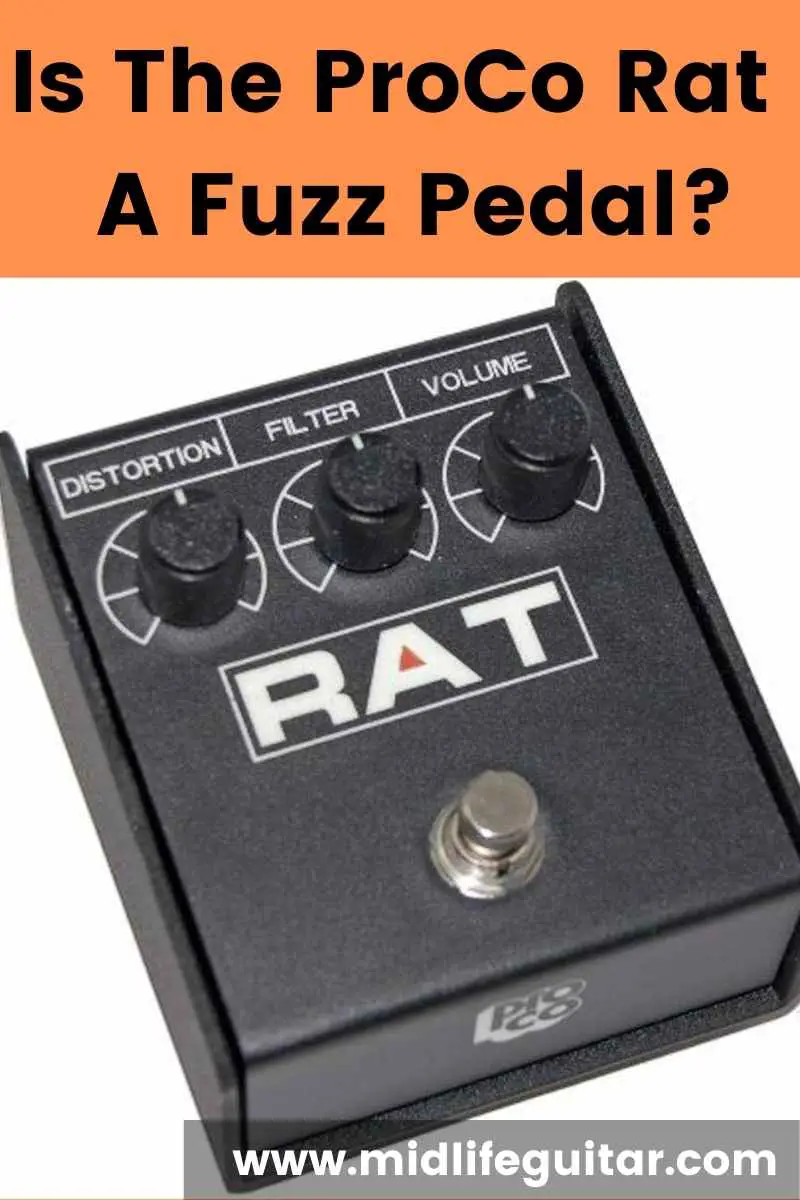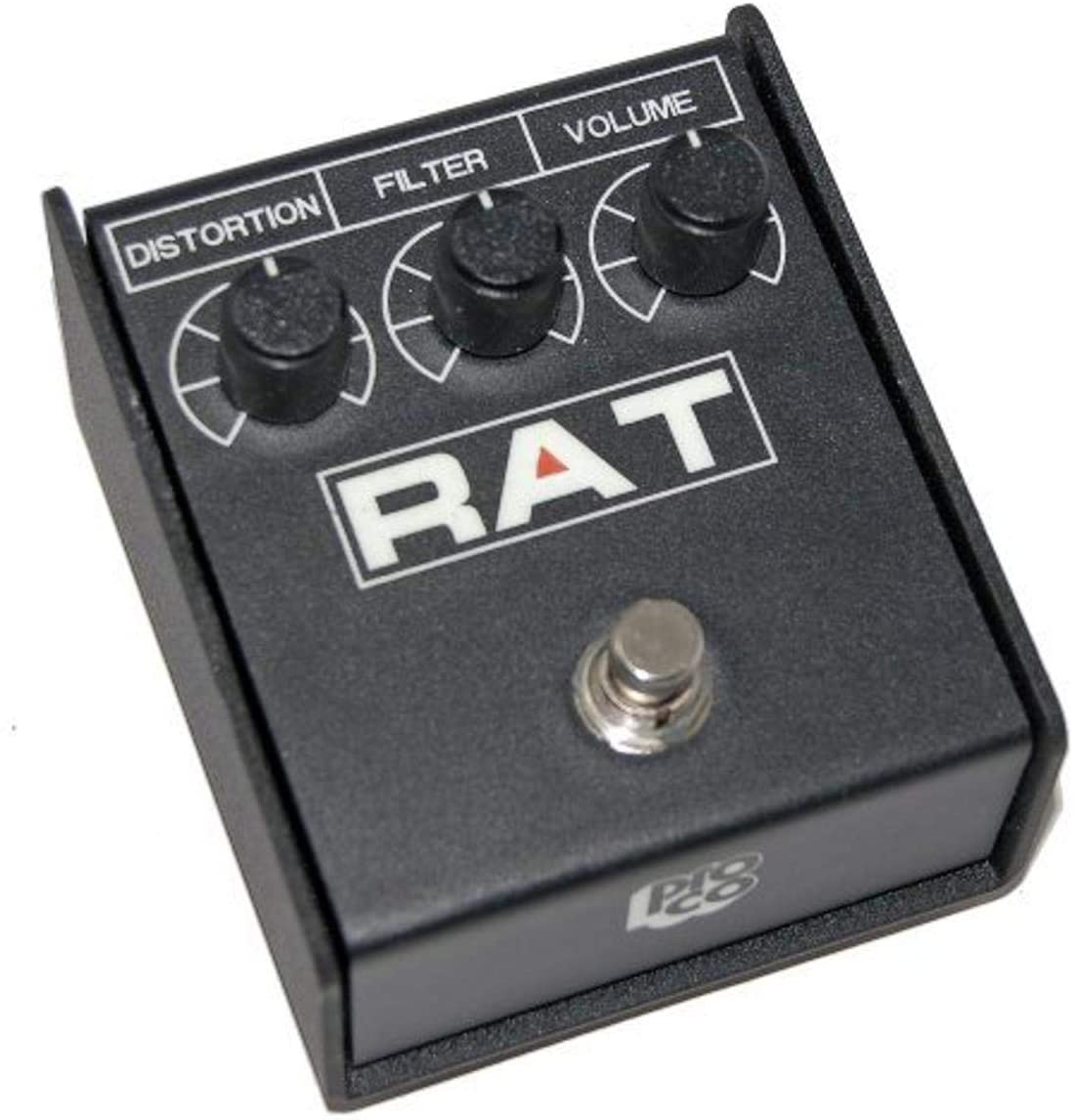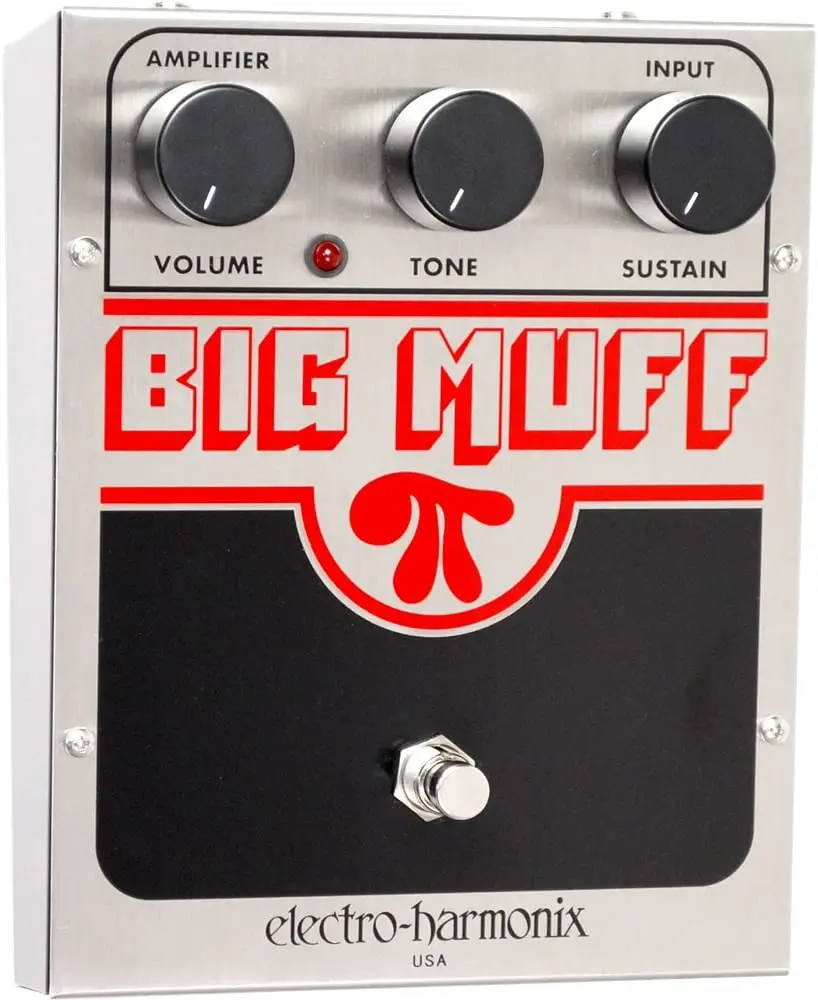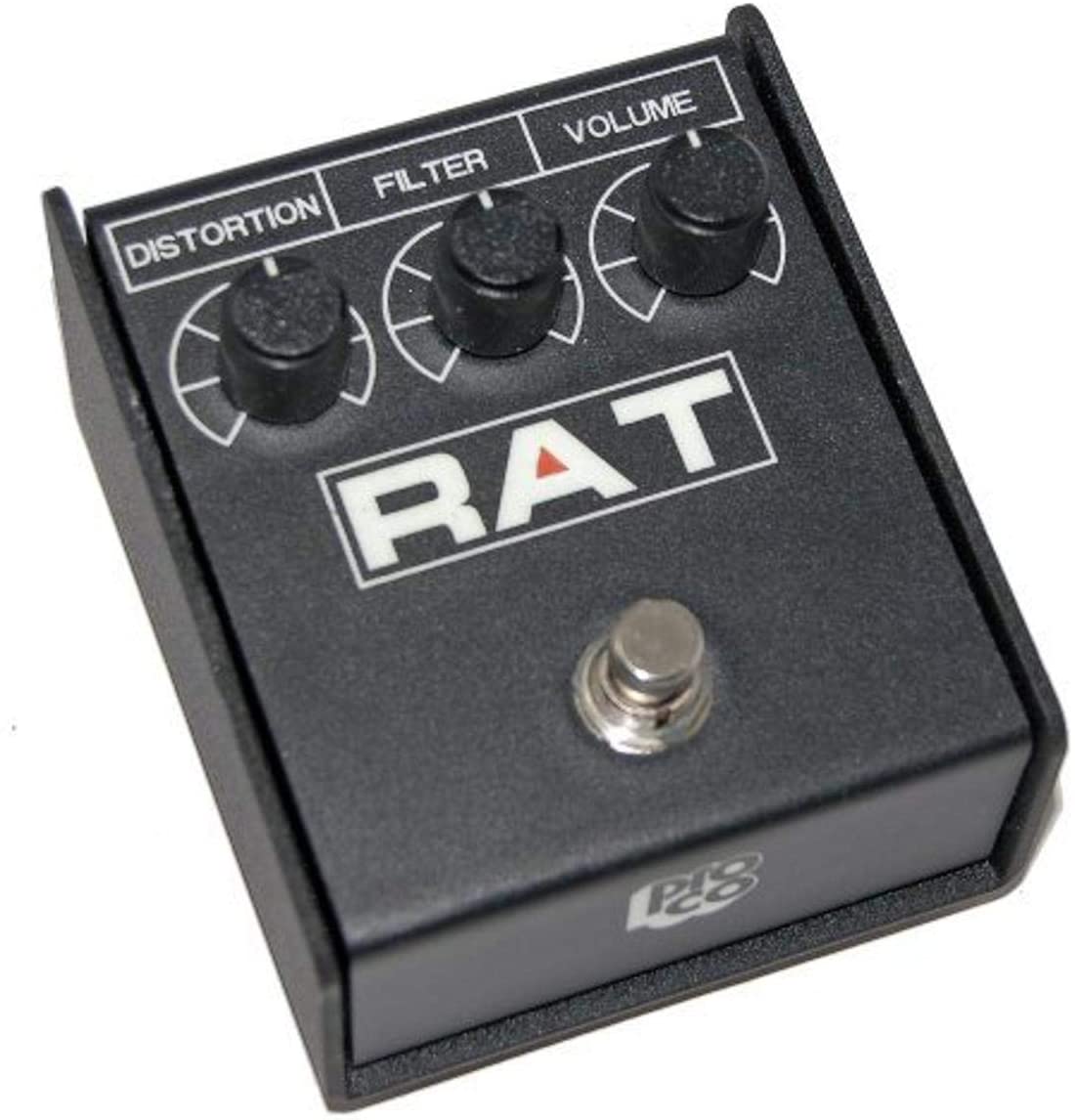
The ProCo Rat defined the sound of many classic hard rock and metal records.
With its sturdy construction and snarling, aggressive tone, it’s no wonder that Alice in Chains, Metallica, and even the Arctic Monkeys have all used the Rat to great effect.
Despite its “fuzzy” qualities, the ProCo Rat is a distortion pedal, not a fuzz pedal. This is because the Rat is not designed to allow harmonic overtones to dominate and overpower the guitar’s tone.
Generally speaking, there are three types of dirt (or non-clean tone) tones for guitar. These are overdrive, distortion, and fuzz.
Somewhat confusingly, guitarists and reviewers occasionally use the terms “distortion” or “drive” to cover all three types, so we’ll quickly clarify a few things here.
Overdrive Pedals

Overdrive pedals use the least gain and compression out of distortion, fuzz, and overdrive pedals.
Overdrive is meant to emulate the sound of a tube amp pushed to its operating limit.
Think AC/DC or classic ZZ Top, and you’ll be in the ballpark for overdrive.
Overdrive pedals are more commonly used in country, rock, and blues.
However, some guitarists in heavier genres will use overdrive pedals to further dirty up an already distorted amp.
Zakk Wylde famously runs a Boss Super Overdrive into a Marshall JCM800 to achieve his distorted tone.
Overdriven tones typically have the clearest note definition and greater dynamic control.
Related: What Are The Different Types Of Marshall Amps, Is Marshall Guitar Amp Good, and 15 Best overdrive pedals for marshall amps
Distortion Pedals

Distortion pedals use more gain and compression than overdrive pedals.
Strictly speaking, distortion involves altering an audio signal to roughen it up.
You can expect more harmonic overtones, greater harmonic saturation, and more sustain than you’d get from a clean signal.
Distortion pedals typically have a harsher, more intense sound than overdrive pedals, with a tighter bass sound.
Metallica used a classic distortion tone in “Master of Puppets,” as did Nirvana with their unforgettable song “Smells Like Teen Spirit.”
Both songs were powered by the ProCo Rat.
Notes are still discernible, but extended chords sound messy. On the other hand, power chords like those on “Smells Like Teen Spirit” sound fantastic.
Fuzz Pedals

Fuzz, or a fuzz tone, is a particular type of distortion that allows harmonic overtones to dominate the sound.
Midrange frequencies give way to upper frequencies.
There is little dynamic difference between single notes and chords, and the guitar’s sound becomes thick and aggressive.
Jimi Hendrix’s “Purple Haze,” Smashing Pumpkins’ “Geek USA,” and The Rolling Stones “Satisfaction” are all classic fuzz tones.
As previously mentioned, the ProCo Rat is a distortion pedal, not a fuzz pedal.
However, guitarists chasing the sound of a fuzz unit will often use the Rat’s distinctive controls, including discrete knobs for both distortion and frequency filtering, to emulate a fuzz tone.
Nonetheless, The ProCo Rat is not a true fuzz pedal like the Big Muff or Maestro FZ1.
Related: 15 Best Overdrive Pedals For Marshall Amps
What Genres Use Fuzz?
Fuzz is a surprisingly commonly used effect. You will hear fuzz tones on everything from classic rock and roll to heavy metal, grunge, indie rock, punk, and stoner rock.
Overdrive is an amp pushed to its limits and distortion as one level beyond that.
Fuzz is an “unnatural” sound that speakers, amplifiers, and instruments are entirely unable to replicate accidentally.
Strictly speaking, you’ll need a fuzz pedal to use the fuzz tone.
My ProCo Rat2 Review

At only $69.99 on Amazon and with a rating star of 4.7 out of 5 stars, this is a must-have pedal.
Below I tell you why this pedal scores so high amongst us guitarists!
Features
The ProCo Rat certainly stands out on my pedalboard.
With its large, square shape, it’s a little taller and much wider than most pedals.
It’s built with steel so thick it feels almost like a weapon in your hand!
Compared to the usual MXR or Boss-sized pedals, the Rat is monstrous in its size.
Fortunately, it’s also monstrous in tone.
I have used the Rat for a few gigs.
This pedal is also very durable. My Rat had beer spilled on it, dealt with my clumsy hoof stomping on it, and was thrown in the back of our Camry more times than I could count, and it lived to tell the tale.
I can’t fault ProCo for their construction.
It’s pretty heavy, and it takes up quite a bit of room on your pedalboard, but that’s the price you pay for battle-ready build quality.
Eventually, I removed the Rat from my live rig because of its considerable heft and massive footprint and reserved it for studio use only.
Control
The Rat has three knobs and a single button.
Step on the button, a little red LED lights up, and the Rat will distort your tone.
Step on it again, and your tone goes back to clean.
The Rat boasts three knobs: volume, distortion, and filter.
Turning the volume knob to the right increases the Rat’s output without noticeably increasing gain. Turning it to the left decreases its output.
This is most useful if you’re using the Rat as a boost for solos or rhythm parts.
If you’re using it as a set-and-forget always-on pedal, the Volume knob is probably the least useful of the three.
The Distortion knob, as you’d expect, controls the amount of gain the Rat offers.
At 12 o’clock, it will provide the kind of intense, aggressive clipping you’d associate with the first Metallica record.
“Think the opening strains of “Seek and Destroy,” and you’re on the right track.”
Turning the distortion knob to the left reduces the intensity of this distortion, not entirely turning the pedal into a tube overdrive, but offering a pleasant amount of dirt.
This won’t replace your Tube Screamer or Boss Super OD as the primary source of amp-like saturation, but in a pinch, it will work.
This is the setting most similar to the distorted tone on the Arctic Monkeys’ “I Bet That You Look Good on the Dancefloor.”
Likewise, the “fuzz” sound of the Rat, incurred by turning your Distortion knob all the way to the right, provides a pleasant enough imitation of a Big Muff or Fuzz Face.
The Rat has an enormous amount of gain at its disposal, far more than I’d be inclined to use with any regularity.
With the Distortion knob maxed out, you’ll be in 90s alt-rock territory, not unlike the mushy, deep distortion of Nevermind-era Nirvana.
The Rat’s Filter knob is its secret weapon.
It allows you to sculpt the EQ of your distorted tone, presenting tremendous versatility for your high-gain endeavors.
You can use the filter knob turned to the left for a rhythm tone and turn it to the right if you feel like a searing high-gain sound.
At 12 o’clock, the Filter knob doesn’t alter the sound of your pedal.
Performance
The control knobs are very sensitive.
Minor tweaks on any of the controls will change your tone, mainly if you’re fiddling with the Filter knob.
Although many buyer’s guides purport the Rat to be an overdrive, distortion, and a fuzz pedal in one box, this is untrue.
In reality, the ProCo Rat is a meat-and-potatoes distortion pedal capable of mimicking overdrive and fuzz.
It will do the trick in a pinch, but I wouldn’t rely on the Rat as my sole source of drive or fuzz.
However, the Pro Co Rat shines when used as a lead guitar boost in front of an already overdriven amp.
My personal preference for lead guitar tone errs more to the sweet, buttery side of things, like Brian May or Gary Moore.
The high saturation and articulation that the Rat is capable of, even at low volume levels, makes it perfect for searing leads.
Typically, I used the ProCo Rat to imitate Justin Hawkins’ lead tone from The Darkness’s debut album, Permission to Land.
Try listening to the outro solo from “I Believe in a Thing Called Love,” and you’ll hear how potent this pedal can really sound.
Power Requirements
You can run the Rat with either a 9-volt power supply or a 9-volt battery.
Conveniently, you don’t need any tools to open the power cavity, so changing batteries before (or during) a gig isn’t an issue.
Conclusion
The ProCo Rat is the Vegemite of guitar pedals. You either love it, or you don’t. There’s no in-between.
For those looking for screaming 80s lead guitar tones, the Rat will deliver the sound of your dreams in spades.
You’ll get the aggressive, harsh sound of British indie rock or the sludgy tone of 1990s grunge with a few tweaks of your distortion and filter knobs.
If you’re looking for a subtle amp-like overdrive or the saturated fuzz sound of the Smashing Pumpkins, look elsewhere. The Electro-Harmonix Big Muff, Maestro’s FZ-1, and the Dunlop Fuzz Face would be great to start with.
The Rat does what it does, and it does it like no other pedal.
Considering that the ProCo Rat has been hogging space on pedalboards since the 1970s, I doubt they’ll be changing the formula any time soon.
